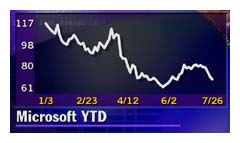|
MSFT files with high court
|
 |
July 26, 2000: 3:25 p.m. ET
Software firm urges Supreme Court to reject direct antitrust appeal
|
NEW YORK (CNNfn) - Microsoft Corp. Wednesday filed a brief with the Supreme Court in which it said the appeal of its antitrust case should be sent to the Court of Appeals, rather than being heard directly by the high court itself.
In a filing called a Jurisdictional Statement, Microsoft said the Supreme Court would benefit from allowing the normal appellate process to move ahead with an initial review of this case by the U.S. Court of Appeals in the District of Columbia.
The Jurisdictional Statement is divided into two sections: a statement summarizing the procedures and facts stated in the antitrust case to date, and Microsoft's argument detailing the reasons the Supreme Court should reject jurisdiction and hand the case to the Court of Appeals.
Antitrust regulators in the Justice Department want the appeal to be heard directly by the Supreme Court because they believe it would result in a more rapid resolution of the case and because the Appeals Court has been friendly to Microsoft in past antitrust matters. The Supreme Court hasn't yet decided whether it is willing to hear the appeal of the Microsoft case without first having the case travel through the Appeals Court, which would provide the High Court with a more slimmed-down record that it could review.
 The federal government and the 19 states suing Microsoft in the antitrust case are scheduled to reply to Microsoft's filing on August 15. The software company then will respond to the government's filing on August 22. The Supreme Court would be free to decide whether it will hear Microsoft's appeal after that date. The high court now is on its summer recess and might not decide whether it will take the case until it returns in October. The federal government and the 19 states suing Microsoft in the antitrust case are scheduled to reply to Microsoft's filing on August 15. The software company then will respond to the government's filing on August 22. The Supreme Court would be free to decide whether it will hear Microsoft's appeal after that date. The high court now is on its summer recess and might not decide whether it will take the case until it returns in October.
U.S. District Court Judge Thomas Penfield Jackson ruled on June 7 that Microsoft should be broken into two smaller companies to prevent it from violating state and federal antitrust laws in the future. In a scathing memorandum that accompanied his 14-page decision, Jackson said he was ordering the breakup because the company was totally unwilling to admit that it had violated federal antitrust law and has shown no willingness to modify its business conduct. However, Jackson delayed the implementation of the breakup order and a series of restrictions on the company's business conduct until after Microsoft has exhausted its appeals.
In its Jurisdictional Statement filed Wednesday, Microsoft argues that a "full and fair consideration" of its appeal would impose an "extraordinary" burden on the Supreme Court, given the extensive trial record that would have to be reviewed and the large number of issues that would have to be considered.
Microsoft said that one of the issues it plans to raise on appeal is whether the district court "erred in entering extreme and punitive relief, including the unprecedented breakup of a unitary operating company that was unrelated to the antitrust violations found." In addition, the software maker plans to raise the issue of whether interviews that Judge Jackson gave to several newspapers "require that the judgment be reversed and, if the cases are remanded, that they be assigned to another district judge."
The high court's procedures are not well adapted to review large trial records, since it normally allows each side only 30 minutes of argument, and up to 24 cases can be heard in a single sitting.
Microsoft's 78-day trial generated a record consisting of 1,815 pages of written direct testimony, 13,466 pages of trial transcript and 2,695 trial exhibits. Much of the evidence relates to technical issues of software design. 
|
|
|
|
|
 |

|

